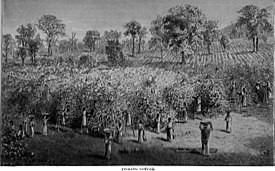History of coffee/ja: Difference between revisions
| Line 234: | Line 234: | ||
19世紀から20世紀初頭にかけての数十年間、ブラジルは最大のコーヒー生産国であり、貿易において事実上の独占者であった。しかし、高価格を維持する政策がすぐに他の国々、例えば[[:en:Venezuela|ベネズエラ]]、[[:en:Colombia|コロンビア]]、[[:en:Guatemala|グアテマラ]]、[[:en:Nicaragua|ニカラグア]]、[[:en:Indonesia|インドネシア]]、そして現在ではブラジルに次ぐ世界第2位の主要コーヒー生産国である[[:en:Vietnam|ベトナム]]に機会を開いた。ベトナムでの大規模生産は、1995年の米国との貿易関係正常化後に始まった。そこで栽培されるコーヒーのほぼすべてがロブスタ種である。 | 19世紀から20世紀初頭にかけての数十年間、ブラジルは最大のコーヒー生産国であり、貿易において事実上の独占者であった。しかし、高価格を維持する政策がすぐに他の国々、例えば[[:en:Venezuela|ベネズエラ]]、[[:en:Colombia|コロンビア]]、[[:en:Guatemala|グアテマラ]]、[[:en:Nicaragua|ニカラグア]]、[[:en:Indonesia|インドネシア]]、そして現在ではブラジルに次ぐ世界第2位の主要コーヒー生産国である[[:en:Vietnam|ベトナム]]に機会を開いた。ベトナムでの大規模生産は、1995年の米国との貿易関係正常化後に始まった。そこで栽培されるコーヒーのほぼすべてがロブスタ種である。 | ||
エチオピアにおけるコーヒー栽培の起源にもかかわらず、同国は20世紀まで輸出量が少なく、その多くは南部の地域からではなく、北東部の[[:en:Harar|ハラル]]周辺からのものであった。コーヒー植物の原産地である[[:en:Kingdom of Kaffa|カッファ王国]]は、1880年代には5万〜6万キログラムのコーヒー豆を生産していたと推定されている。商業生産は、1907年に内陸港[[:en:Gambela, Ethiopia|ガンベラ]]が設立されてから本格的に始まった。1908年にはガンベラから10万キログラムのコーヒーが輸出され、1927年から1928年には400万キログラム以上がその港を通過した。コーヒー農園は同時期に[[:en:Arsi Province|アルシ州]]でも開発され、最終的には[[:en:Imperial Railway Company of Ethiopia|アディスアベバ-ジブチ鉄道]]によって輸出された。鉄道による輸送量は当初24万5千キログラムであったが、1922年には224万キログラムに跳ね上がり、1925年には「ハラリ」コーヒーの輸出量を上回り、1936年には926万キログラムに達した。 | |||
<div lang="en" dir="ltr" class="mw-content-ltr"> | <div lang="en" dir="ltr" class="mw-content-ltr"> | ||
Revision as of 17:26, 2 June 2025


コーヒーの歴史は何世紀にもわたるものであり、その起源はエチオピアに、そして後にイエメンにある。15世紀にはすでにメッカで知られていた。また、15世紀のイエメンのスーフィーのイスラム修道院(ハンカー)では、祈りの際の集中力を高めるためにコーヒーが用いられた。コーヒーは後に16世紀初頭にレバントに広まった。しかし、オスマン帝国やマムルーク朝社会では、それがハラールであるか否かをめぐって一部論争が起きた。コーヒーは16世紀後半に地中海の商業貿易路を通じてイタリアに伝わり、一方、中央ヨーロッパと東ヨーロッパの国々はオスマン帝国からコーヒーを知った。17世紀半ばまでには、インドや東インド諸島にまで到達していたである。

コーヒーハウスは、17世紀後半までに西ヨーロッパ、特にオランダ、イングランド、ドイツで設立された。新世界におけるコーヒーの最も初期の栽培の一つは、1720年にガブリエル・ド・クリューがマルティニークにコーヒーの苗木をもたらした時であった。これらの豆は後に18,680本のコーヒーの木に成長し、サン=ドマングなどの他のカリブ海の島々やメキシコへの普及を可能にした。1788年までに、サン=ドマングは世界のコーヒーの半分を供給したである。
1852年までにブラジルは世界最大のコーヒー生産国となり、それ以来その地位を維持している。1950年以降、コロンビア、コートジボワール、エチオピア、ベトナムなど、いくつかの主要な生産国が出現した。特にベトナムは1999年にコロンビアを抜き、第2位の生産国となったである。
今日、コーヒーは世界で最も人気のある飲料の一つであり、世界的に大きな文化的・経済的影響を与えているである。
語源
コーヒーという言葉は、1582年にオランダ語のkoffieを介して英語に入った。これはオスマン・トルコ語の「kahve (قهوه)」から借用され、さらにこれはアラビア語の「qahwah (قَهْوَة)」から借用されたものである。中世のアラビア語辞書編纂者たちは伝統的に、「qahwah」の語源は、その独特の濃い色から「ワイン」を意味するとし、動詞「qahiya (قَهِيَ)」、すなわち「食欲がない」に由来するとした。しかし、「qahwah」という言葉は、飲み物や豆を指して「暗い」という意味であった可能性が最も高い。セム語派には「qhh」という語根があり、「濃い色」を意味し、それがこの飲み物の自然な呼称となった。この言葉がカッファ県(コーヒーの起源であるアビシニアの一部)というエチオピアの州にちなんで名付けられたという証拠はなく、またその反対を主張する有力な根拠もないし、アラビア語の「quwwa」(「power」)に由来するという証拠もない。 「コーヒー」を意味する別の言葉で、エチオピアの言語で広く使われているものに、buna、bun、būn、またはbuni(言語による)がある。この語群は、アラビア語の「bunn (بن)」、特にコーヒー豆を意味する言葉に由来するとされることが多いが、クシ語派に固有の起源がある可能性も提案されている。
オスマン帝国がコーヒー貿易において優位な地位にあったことは、他のいくつかのヨーロッパ言語にも影響を与えたと考えられており、イタリア語の「caffè」やフランス語の「cafécafé」の語源となった。これらの用語は、オランダ語の「koffie」とほぼ同時期に出現し、ヨーロッパ全体へのコーヒーの新たな広がりを反映している。
「コーヒーポット」と「コーヒーブレイク」という言葉は、それぞれ1705年と1952年に生まれたものである。
遺伝学
アラビカ種の品種に関する遺伝的多様性の研究が行われてきた。これらの研究では、多様性は低いものの、祖先系統から残存するいくつかの異型接合性が保持されていることが判明しており、また近縁の二倍体種であるロブスタ種やリベリカ種との関連も示されている。しかし、アフリカのどこでコーヒーが栽培されていたか、あるいは17世紀以前に現地の人々の誰が刺激物としてコーヒーを使用していたか、あるいはその存在を知っていたかを示す直接的な証拠はこれまで見つかっていない。原種の栽培コーヒーはハラルに由来するとされ、その在来個体群はエチオピアに起源を持ち、スーダンとケニアに近縁の異なる個体群が存在すると考えられている。
歴史



文学的なコーヒー商人フィリップ・シルヴェストル・デュフールが記したコーヒーに関する最も初期の記述は、10世紀のペルシア人医師ムハンマド・イブン・ザカリヤ・アル=ラージー(西洋ではラゼスとして知られる)の著作における「bunchum」への言及である。焙煎したコーヒー豆から飲み物を調製するコーヒーの木と調製に関するより明確な情報は、15世紀後半に遡る。スーフィーのイマーム、ムハンマド・イブン・サイード・アル=ダバニがエチオピアからイエメンへ商品を輸入したことで知られている。コーヒーは、ベルベラとゼイラのソマリ人商人がハラルやアビシニア内陸部から調達したものを、エチオピアからイエメンへ初めて輸出した。アデンの植民地行政官であったヘインズ大尉(1839年-1854年)によると、モカは歴史的に、19世紀にイギリスが支配するアデンがモカのコーヒー貿易を掌握するまで、コーヒーの最大3分の2をベルベラを拠点とする商人から輸入していた。その後、エチオピアのコーヒーの多くはベルベラ経由でアデンに輸出されたである。
ベルベラはアデンに非常に大量の有角牛と羊を供給するだけでなく、アフリカとアデンの間の貿易は毎年着実に大きく増加している。コーヒーだけでも相当量の輸出があり、現在ボンベイ市場では「ベルベラ」コーヒーがモカよりも優位に立っている。ベルベラで積み出されるコーヒーは、はるか内陸のフルラル、アビシニア、カッファから来る。貿易がすべてアデンに一つの港を通じて行われることは、すべての人にとって有利であり、ベルベラはそこにある海岸で、船が穏やかな水域に停泊できる唯一の保護された港である。
コーヒーに関する初期の最も重要な著述家の一人が、1587年にコーヒーの歴史と法的な論争をたどる著作『Umdat al Safwa fi hill al-qahwa(عمدة الصفوة في حل القهوة)』を編纂したアブド・アル=カーディル・アル=ジャズィーリーである。この著作は、コーヒーが「幸福のアラビア」(現在のイエメン)から北方のメッカやメディナ、そしてさらに大きな都市であるカイロ、ダマスカス、バグダッド、コンスタンティノープルへと広まった経緯をたどっている。彼は、アデンのムフティであるシャイフ、ジャマール・アッディーン・アル=ダバーニ(1470年没)が、最初にコーヒーの使用を採用した(およそ1454年)と報告している。
彼はその効能の中に、疲労や倦怠感を払い、体に一定の活気と活力をもたらすことを見出した。
アル=ジャズィーリーの写本は、ヨーロッパにおけるコーヒーの歴史に関しても非常に興味深い。その写本の一部はフランス王立図書館に所蔵され、アントワーヌ・ガランによって『De l'origine et du progrès du café』(1699年)として部分的に翻訳されたである。
中東
イエメンのスーフィーたちは、この飲み物を集中力の助けとして、また神の名を唱える際の精神的な陶酔の一種として利用した。スーフィーたちは夜間の礼拝中に覚醒状態を保つためにそれを用いた。1414年までにこの植物はメッカで知られるようになり、1500年代初頭にはイエメンのモカ港からエジプトと北アフリカのマムルーク朝へと広まった。スーフィズムに関連して、アズハル大学周辺のカイロ(エジプト)には無数のコーヒーハウスが出現した。これらのコーヒーハウスはシリア、特に国際都市アレッポにも開設され、その後1554年にはオスマン帝国の首都コンスタンティノープルにも広がった。コーヒーは1573年にドイツ人医師植物学者レオンハルト・ラウヴォルフによって「chaube」としてアレッポで言及されており、これはコーヒーについて言及した最初のヨーロッパ人である。ラウヴォルフの記述に続いて、他のヨーロッパ人旅行者による記述が続いた。
1511年、メッカの神学法廷で保守的な正統派イマームによって、その覚醒作用を理由に禁止された。しかし、これらの禁止令は1524年にオスマン・トルコのスルタンスレイマン1世の命令によって覆され、大ムフティメフメト・エブスースード・エル=イマーディがコーヒーの摂取を許可するファトワーを発令した。カイロでは1532年に同様の禁止令が敷かれ、コーヒーハウスとコーヒー豆を貯蔵する倉庫が略奪された。16世紀の間には、すでに中東の他の地域、サファヴィー朝、そしてオスマン帝国にまで到達していた。中東からコーヒーを飲む習慣はイタリア、そしてヨーロッパの他の地域へと広がり、コーヒーの木はオランダ人によって東インドとアメリカ大陸に運ばれたである。
エチオピアにおけるコーヒーの規制
コーヒーは18世紀以前のある時期にエチオピア正教会によって禁止された。しかし、19世紀後半になると、エチオピア人のコーヒー飲用に対する態度が軟化し、1880年から1886年の間にその消費が急速に広まった。リチャード・パンクハーストによると、「これは主に、自らもコーヒーを飲んだ皇帝メネリク2世と、コーヒーがムスリムの飲み物であるという聖職者の信仰を払拭するために多大な貢献をしたアブナマテウォスの功績によるものであった。」
イスラムにおけるコーヒー
初期のイスラム医学と科学の実践者たちは、コーヒーの効果がハシシやアルコールのようなものであるという考えに反論し、代わりにアルコールやハシシの誘惑から身を守りながら精神を刺激するこの飲み物の利点を主張した。メッカ、イエメン、カイロのコーヒーハウスは爆発的な人気を博し始め、やがてイスラム帝国の広大な都市における公共生活の中心となる。コーヒーハウスは時に、イスラムの生活、芸術、思想の中心であったバイト・アル=ヒクマやマドラサのように機能した。フォルジャー・シェイクスピア図書館のネハ・ヴェラミは、「これらのコーヒーハウスの歴史は、公共圏の出現、近世イスラム帝国の政治生活へのより広範な人々の参加、そして西洋の傍観者による『東洋』社会への専制政治の疑惑の空虚さという、3つの関連する洞察を提供する」と述べている。コーヒーは、その後数世紀にわたってイスラム文化に深く根付いたのである。
近世紀における役割とは対照的に、コーヒーは一部で議論の対象となった。1532年から1533年にかけてファトワーが発効された際、コーヒーとその消費はハラムと定められた。この決定は、アルコールと同様にコーヒーも認知に影響を与えるという考えから来たとみられるが、その影響は異なり、より穏やかなものであった。この規制は、オスマン帝国とサファヴィー朝において、タバコやアルコールなどの他の嗜好品の消費を制限しようとする試みとして実施された可能性もある。公共の場所でのコーヒー飲用もまた、蔑視された。公共での消費がタブー視されただけでなく、人々はワインを飲むのと同様の方法で共同のボウルから飲むことが多かった。このことは、コーヒーの飲用様式が再びアルコールと関連付けられたため、コーヒーに対する軽蔑の一因となった可能性が最も高いである。
コーヒーの人気が高まるのを抑えようとする試みがなされた。スレイマン1世がまだ権力を握っていた頃、官僚と失業者の両方がコーヒーを消費するのを防ぐ目的で税金が課された。さらなる試みは、1567年のセリム2世と1583年のムラト3世の治世中にも行われた。これは、職人から店主、地元の兵士まで、より控えめな収入の人々がコーヒーを飲み始めた時であった。コーヒーの飲用を禁じる試みにもかかわらず、コーヒーはアルコールの影響とは比較にならなかったため、ファトワーは最終的に失敗に終わった。コーヒーもアルコールと同様に精神を変える物質と見なされたため、この禁止は物質に対する誤解、あるいは正統派の信仰に基づいて消費を管理しようとする試みであった可能性が高い。この一進一退の状況は、コーヒーが「ハラール」か「ハラム」かという議論に当てはまる。確かに論争を巻き起こしたが、コーヒーは多くの人々に求められ続けたである。
オスマン帝国では、オスマン・トルコ語で「taḥmīskhāne」として知られる店が、コーヒー豆を焙煎し、臼で砕くという伝統的な方法でコーヒーを作るために使われた。メッカなどの地域にあるコーヒーハウスには、モスクからのイスラム教徒、遠方から貿易や販売に来る人々、あるいは単なる旅行者など、あらゆる場所からの人々が訪れた。
コーヒーをめぐる論争にもかかわらず、コーヒーは15世紀半ばから17世紀半ばにかけて紅海周辺の経済の鍵の一つであった。かつて、エチオピアのオロモ族は、バター、塩、焙煎した豆で作る「bunna qela」など、コーヒーの木から食物を作った。このような調合品は基本となり、時間の経過とともに変化した。アラビア語で「qishr」として知られるより現代的な飲み物は、通常「buna」という飲み物を作るのに使われた後、捨てられるはずだった乾燥したチェリーの皮を再利用して作られる。これらのチェリーの皮は、一種のフルーツティーを淹れるのに使われる。Qishrまたはスペイン語でcascaraは、今日でもコーヒー農家によって販売されているである。
伝説的な説明
コーヒー消費の起源については、いくつかの伝説的な説明が存在する。ある伝説によると、Kaffa王国の今日のカフィチョ族の祖先が、コーヒー植物の活力を与える効果を最初に認識したとされる。ある説では、9世紀のエチオピアのヤギ飼いであるカルディが、自分の群れが特定の低木の明るい赤い実をかじったときに活力を与える効果があることに気づき、自らその実を噛んでみた。彼の高揚感は、その実を近くの修道院の修道士に持って行かせた。しかし、その修道士はそれらの使用を認めず、火に投げ入れたところ、魅力的な香りが立ち上り、他の修道士たちが調べてみるためにやってきた。焙煎された豆はすぐに燃えさしから掻き出され、挽かれ、熱湯に溶かされ、世界初のコーヒーが誕生した。この話は、1671年にローマに拠点を置くマロン派のファウストゥス・ナイロンの『De Saluberrima potione Cahue seu Cafe nuncupata Discurscus』が出版されるまで文字で記述されたことが知られておらず、またそれが起こったとされる時期から800年後であるため、この話は多分に偽りである可能性が高い。
別の説では、13世紀のモロッコのスーフィー神秘家ゴートゥル・アクバル・ヌールディン・アブ・アル=ハサン・アル=シャディリが関わっている。伝説によると、彼がエチオピアを旅していた際、異常なほど活発な鳥がベリーを食べているのを目撃し、そのベリーを試したところ、同じような活力を経験したという。また別の説では、コーヒーの発見をシャイフ・アブ・アル=ハサン・アッシュ=シャディリの弟子であるオマールに帰している。古代の年代記(アブド・アル=カーディル写本に保存されている)によると、祈りによって病人を治す能力で知られていたオマールは、かつてメッカからオウサブ市近くの砂漠の洞窟に追放された。飢えに苦しんだオマールは、近くの低木のベリーを噛んだが、苦すぎると感じた。彼は風味を改善しようと豆を焙煎したが、硬くなりすぎた。そこで彼は豆を柔らかくしようと煮てみたところ、香りの良い褐色の液体ができた。その液体を飲むと、オマールは回復し、数日間生き延びた。この「奇跡の薬」の話がメッカに届くと、オマールは戻るよう求められ、最終的に聖者となったである。
ネペンテス(/nɪˈpɛnθi/、Ancient Greek: νηπενθές、nēpenthés)は、ホメロス叙事詩におけるコーヒーの誤解に由来する可能性がある。エジプトを起源として言及されている。nepentheという言葉は、ホメロスの『オデュッセイア』第4巻に初めて登場する。
ἔνθ᾽ αὖτ᾽ ἄλλ᾽ ἐνόησ᾽ Ἑλένη Διὸς ἐκγεγαυῖα: |
|
| —オデッセイ、第4巻、219-221行 |
比喩的に、ネペンテスは「悲しみを追い払うもの」を意味する。文字通りには「悲しみがない」あるいは「反悲しみ」を意味し、νη-、nē-、すなわち「〜でない」(否定の接頭辞)と、πενθές、これはπένθος、pénthosに由来し、すなわち「悲嘆、悲しみ、または喪」である。
オデュッセイにおいて、νηπενθές φάρμακον: nēpenthés phármakon(すなわち抗悲しみ薬)は、高貴なエジプト人トン(Thon)の妻ポリダムナがヘレネに与えた魔法の薬である。
コーヒーはもともとイスラム世界で飲用され、宗教的な慣習と直接関連していた。例えば、コーヒーはイスラム教のラマダンの祝祭の間、信者が日中は断食し、夜は覚醒を保つのに役立った。
それ(コーヒー)はムハンマドの誕生日と関連付けられるようになった。実際、様々な伝説がコーヒーの起源をムハンマドに帰しており、彼は大天使ガブリエルを通じて、イスラムが禁じたワインの代わりとして人類にコーヒーをもたらした。
ヨーロッパ

コーヒーがヨーロッパに初めて伝えられたのはハンガリーで、1526年のモハーチの戦いでトルコ軍がハンガリーに侵攻した時である。それから1年以内に、ウィーン包囲 (1529年)でヨーロッパ軍と戦った同じトルコ人によって、コーヒーはウィーンに到達した。16世紀後半には、コーヒーは奴隷制度を通じてマルタ島に導入された。1565年のマルタ大包囲戦の年に、聖ヨハネ騎士団によって投獄されたトルコ系ムスリムの奴隷たちが、彼らの伝統的な飲料を作るために使われた。ドメニコ・マーグリは自身の著作『Virtu del Kafé』の中で、「この調合の最も熟練した作り手であるトルコ人」と述べている。また、ドイツの旅行者グスタフ・ゾンマーフェルトは1663年にこう記している。 「トルコ人捕虜たちが、特に水と砂糖を使って嗅ぎタバコに似た粉末であるコーヒーを準備することで、いくらかの金銭を稼ぐ能力と勤勉さ。」コーヒーはマルタの上流社会で人気のある飲料となり、多くのコーヒーショップが開店した。
ヨーロッパの文献におけるコーヒーの最初の言及は、シャルル・ド・レクリューズの1575年の著書『Aromatum et simplicium aliquot medica-mentorum apud Indos nascientum historia』である。彼はパドヴァのアルフォンシウパンシウスからコーヒーについて学んだ。16世紀後半にサファヴィー朝とオスマン帝国を通過したイギリス人は、コーヒーが「消化を助け、精神を活気づけ、血液を浄化するのに非常に良い」と記している。
ヴェネツィア共和国と北アフリカ、エジプト、そして「東方」の人々との活発な貿易は、コーヒーを含む多種多様なアフリカの品々をこの主要なヨーロッパの港にもたらした。ヴェネツィアの商人たちはヴェネツィアの富裕層にコーヒーを飲む習慣を紹介し、その飲料に高額な料金を請求した。このようにして、コーヒーはヨーロッパ本土に導入された。1591年、ヴェネツィアの植物学者・医師であるプロスペロ・アルピーニが、ヨーロッパで初めてコーヒー植物の記述を出版した。オスマン帝国とマルタを除くヨーロッパで最初のコーヒーハウスは1645年にヴェネツィアで開店した。
コーヒーの最初の伝播経路は、広大なオスマン帝国を通じてであり、コーヒーなどの物品がヨーロッパ深くへと運ばれることを可能にした。2番目の伝播経路はイエメンのモカ港からで、東インド貿易会社が大量のコーヒーを買い付け、ヨーロッパ本土へと運んだ。コーヒーはヨーロッパのほとんどの地域で文化の重要な一部となり、女王、王、そして一般大衆の誰もがこの製品に深く魅了された。コーヒーの西洋世界への伝播は、「コーヒーアラビカ」という用語を通じてであれ、飲み物の輸送を通じてであれ、イスラム世界帝国によって伝えられた科学的知識や発見の伝播と非常によく似ているである。
オーストリア

オーストリアで最初のコーヒーハウスは、1683年のウィーンの戦い後、トルコ軍を破って得た戦利品を使ってウィーンに開店した。コーヒー豆を受け取った将校であるポーランド軍の将校イェジ・フランツィシェク・クルチツキ(ゲオルグ・フランツ・コルシツキー)は、コーヒーハウスを開店し、コーヒーに砂糖と牛乳を加える習慣を広めるのに貢献した。メランジェは典型的なウィーンコーヒーで、温かい泡立てた牛乳と混ぜて提供され、通常は水のグラスが添えられる。
独特のウィーンコーヒーハウス文化は19世紀にウィーンで発展し、その後中央ヨーロッパ全域に広まった。科学者、芸術家、知識人、美食家、そして彼らの金融家たちは、ハプスブルク帝国のウィーンコーヒーハウスというこの特別な小宇宙で出会った。グスタフ・クリムト、ジークムント・フロイト、ジェイムズ・ジョイス、エゴン・シーレといった世界的に有名な著名人もウィーンコーヒーハウスでインスピレーションを得た。多文化的なハプスブルク帝国のこの多様なコーヒーハウス文化の中で、様々な種類のコーヒー調製法も発展した。こうして、ウィーンの「カプツィーナーコーヒー」から、北イタリア帝国のイタリア語圏を経て、世界的に有名なカプチーノが発展したである。
イギリス

イングランドで最初のコーヒーハウスは、1650年にオックスフォードで開店した。ロンドンで最初のコーヒーハウスは、コーンヒルのセント・マイケルズ・アレーに開店した。経営者はトルコ商品を扱う貿易商ダニエル・エドワーズの召使いであったパスクア・ロゼーである。エドワーズがコーヒーを輸入し、ロゼーが店の設立を手伝った。コーヒーは17世紀にイギリス東インド会社とオランダ東インド会社を通じても輸入された。オックスフォードのクイーンズ・レーン・コーヒーハウスは1654年に設立され、今日でも存在している。1675年までに、イングランド全土に3,000以上のコーヒーハウスがあったが、1660年代から1670年代にかけてコーヒーハウスの進歩的な動きには多くの混乱があった。啓蒙時代には、これらの初期のイギリスのコーヒーハウスは、国民の間で深い宗教的および政治的議論のための集会場所として利用された。これは、冷静な議論ができる珍しい機会であったためである。この慣行は非常に一般的で、潜在的に反体制的になったため、チャールズ2世は1670年代にコーヒーハウスを弾圧しようと試みた。
コーヒーハウスから女性を排除する動きは普遍的ではなく、例えばドイツでは女性も頻繁に利用していたが、イングランドを含むヨーロッパの他の地域では一般的であったようである。
この時代、多くの人々はコーヒーに薬効があると信じていた。著名で高名な医師たちは、しばしばコーヒーを薬用として推奨し、神経障害の治療薬として処方することもあった。1661年に「M.P.」という人物によって書かれた「A character of coffee and coffee-houses」と題された小冊子には、これらの認識されていた効能がいくつか挙げられている。
胃の消化不良を乾燥させ、頭からガスを排出するのに賞賛される。素晴らしいベリーだ!英国人の胃の痰を取り除き、頭のめまいを追放することができる。
しかし、この新しい商品は一部の人々の間で物議を醸した。例えば、匿名の1674年の「コーヒーに反対する女性たちの請願」にはこう記されている。
「コーヒー」と呼ばれるその新奇で忌まわしい異教の液体の過度の使用は...私たちの夫を「去勢」し、より親切な「恋人たち」を「不具」にし、彼らは老人のように「無力」になった。
フランス
アントワーヌ・ガラン(1646年-1715年)は、前述の自身の翻訳で、コーヒー、茶、チョコレートとイスラム教徒との関連について述べている。「我々は、コーヒー、砂糖、茶、チョコレートを彼らの著作を通じて現代世界に紹介してくれたこれらの偉大な[アラブの]医師たちに負っている」。しかし、この最後(チョコレート)に関しては、スペイン人によってアメリカ大陸からヨーロッパにもたらされたものであったため、彼は完全に誤っていた。ガランは、フランス国王ルイ14世の通訳であるド・ラ・クロワ氏から、コーヒーは東方を旅したテヴノー氏によってパリにもたらされたと知らされたと報告している。1657年に彼がパリに戻った際、テヴノーは豆の一部を友人たちに与え、その中にはド・ラ・クロワもいた。
1669年、メフメト4世スルタンからの大使であるスレイマン・アガは、大量のコーヒー豆を携えて従者とともにパリに到着した。彼らはフランス人およびヨーロッパ人の客にコーヒーを飲ませただけでなく、王室にも豆を寄贈した。1669年7月から1670年5月の間、大使はパリ市民の間にコーヒーを飲む習慣をしっかりと確立することに成功したである。
ドイツ
ドイツでは、コーヒーハウスは最初にヴッパータール=ロンスドルフ(1673年)やハンブルク(1677年)を含む北海沿岸の港で設立された。当初、この新しい飲み物は英語のcoffeeという形で書かれていたが、1700年代中にドイツ人は徐々にフランス語のcaféを採用し、その後ゆっくりとスペルをKaffee(現在の単語)に変えた。18世紀にはコーヒーの人気がドイツ各地に徐々に広まり、支配階級にも取り入れられた。コーヒーは早くも1675年には大選帝侯ブランデンブルク選帝侯フリードリヒ・ヴィルヘルムの宮廷で提供されていたが、ベルリン初の公共コーヒーハウスは1721年まで開店しなかった。

ライプツィヒの聖トーマス教会のカントルであった作曲家ヨハン・ゼバスティアン・バッハは、1723年から1750年にかけて地元のツィンマーマン・カフェで音楽アンサンブルを指揮した。1732年から1735年のいずれかの時期に、彼は世俗カンタータ「コーヒー・カンタータ」Schweigt stille, plaudert nicht(BWV 211)を作曲した。このカンタータでは、若い女性リーシェンが、当時流行の最先端であったコーヒーを飲むことへの彼女の傾倒を、反対する父親に受け入れるよう懇願する。台本には次のような歌詞が含まれている。
Ei! wie schmeckt der Coffee süße,
Lieblicher als tausend Küsse,
Milder als Muskatenwein.
Coffee, Coffee muss ich haben,
Und wenn jemand mich will laben,
Ach, so schenkt mir Coffee ein!
(Oh! How sweet coffee does taste,
Better than a thousand kisses,
Milder than muscat wine.
Coffee, coffee, I've got to have it,
And if someone wants to perk me up, *
Oh, just give me a cup of coffee!)
イタリア

イタリアでは、ヨーロッパのほとんどの地域と同様に、コーヒーは16世紀後半に地中海の商業路を通じて伝わった。1580年、ヴェネツィアの植物学者で医師のプロスペロ・アルピーニがエジプトからヴェネツィア共和国にコーヒーを輸入し、コーヒーが広まって知識人や社交の場、さらには恋人たちの飲み物となるにつれて、次々とコーヒーショップが開店し、チョコレートとコーヒーの皿はロマンチックな贈り物と見なされた。1763年までにヴェネツィアだけで200以上のコーヒーショップがあり、この奇跡の飲み物の健康上の利点は多くの人々に称賛された。カトリック教会の一部代表者は、コーヒーがイタリアに最初に導入された際、「悪魔の飲み物」であると信じて反対したが、教皇クレメンス8世は自らこの香りの良い飲み物を試した後、祝福を与え、その商業的成功と普及をさらに促進した。コーヒーを味わった教皇クレメンス8世は、「なぜ、この悪魔の飲み物はこれほどおいしいのか、異教徒が独占的に使用させるのはもったいない」と宣言した。クレメンスは、コーヒーがアルコール飲料よりも人々に良いように思われたため、豆を祝福したとされる。しばしば引用される年は1600年である。これが真実の物語であるかは不明だが、当時としては面白い話だったのかもしれない。
1933年、トリノでイタリア人エンジニアのルイージ・ディ・ポンティが最初のモカポットを発明し、後にその特許をアルフォンソ・ビアレッティに売却した。1946年、アルフォンソの息子レナートが工業生産を開始し、わずか1年間で数百万個のモカポットを販売した(彼の父親がそれまでの10年間で販売したのはわずか7万個であった)ことにより、このコーヒーメーカー(そしてコーヒー)は世界におけるイタリアの象徴となった。今日、コーヒーの街として知られているナポリには、おそらくシチリア島やナポリ自身の港に入港する船を通じて、より遅くコーヒーが伝わった。ナポリでのコーヒーの発見は、1614年に作曲家、探検家、音楽学者のピエトロ・デッラ・ヴァッレが聖地から、親愛なる友人である医師、詩人、ギリシャ学者マリオ・スキパノとその知識人仲間への手紙の中で、アラブのイスラム教徒が熱い鍋で淹れる飲み物(「カフヴェ」と呼ばれる)のニュースを送った時に遡るとする説もある。
コーヒーがナポリにさらに早く、サレルノとそのサレルノ医学校から伝わったと信じる者もいる。そこでは、14世紀から15世紀にかけて、コーヒー植物がその薬効のために使われるようになった。ナポリの芸術、文学、音楽、そして日常の社会生活で称賛されたコーヒーは、まもなくナポリの主役となり、1819年にパリのモリゼの発明に由来する典型的なナポリのフィルターコーヒーポット「クックメッラ」で細心の注意を払って淹れられた。ナポリの職人たちは、再び海の商業路を通じてナポリ港に持ち込まれた際にそれに触れたのである。ナポリの人々がコーヒーを社交的な飲み物として捉えていることを示すものに、サスペンデッド・コーヒー(次に利用する客のためにコーヒー代を前払いする行為)の習慣がある。これはナポリで発明され、ナポリの哲学者・作家であるルチアーノ・デ・クレシェンツォによって「個人から人類への贈り物」と定義されたコーヒーである。
オランダ
生きたコーヒーの木や豆を手に入れようとするヨーロッパ諸国の競争は、最終的に1616年にオランダ人が制した。オランダの商人ピーテル・ファン・デン・ブローケは、1616年にイエメンのモカから厳重に管理されていたコーヒーの木をいくつか入手した。彼はそれらをアムステルダムに持ち帰り、植物園で居場所を見つけ、そこで繁茂し始めた。この一見些細な出来事はほとんど公にならなかったが、コーヒーの歴史に大きな影響を与えることになった。
ファン・デン・ブローケが40年前にモカから入手した豆は、アムステルダム植物園の温室の環境によく適応し、数多くの健康なアラビカ種の木を生産した。1658年、オランダはこれらを最初にセイロン島(現在のスリランカ)で、後にインド南部でコーヒー栽培を開始するために利用した。彼らは過剰供給による価格下落を避けるため、ジャワのプランテーションに集中するためにこの栽培を放棄した。
数年以内に、オランダの植民地(アジアのジャワ、アメリカ大陸のスリナム)はヨーロッパへのコーヒーの主要供給源となったである。
ポーランド
コーヒーは17世紀にポーランド・リトアニア共和国に到達し、主に隣接するオスマン帝国との貿易商人を通じて伝わった。最初のコーヒーショップは1世紀後に開店した。1989年の政変以降、コーヒーの摂取量は増加したが、一人当たりの消費量はほとんどのヨーロッパ諸国よりも低い。コーヒーを含むあらゆるものが不足していた共産主義時代には、ポーランド人は焙煎穀物から作られた独自のコーヒー代替品、インカを開発した。 今日、ポーランドではカフェの急速な拡大と、スペシャルティコーヒーのような新しいトレンドを通じて、コーヒー消費が爆発的に増加しているである。
アメリカ大陸

ガブリエル・ド・クリューは1720年にカリブ海のマルティニークにコーヒーの苗木をもたらした。これらの苗木は繁茂し、50年後にはマルティニークに18,680本のコーヒーの木が生い茂り、サン=ドマング(ハイチ)、メキシコ、その他のカリブ海の島々へのコーヒー栽培の拡大を可能にした。フランス領のサン=ドマングでは1734年にコーヒー栽培が始まり、1788年までに世界のコーヒーの半分を供給した。コーヒーはラテンアメリカの地理に大きな影響を与えた。フランスの植民地プランテーションはアフリカ人奴隷労働者に大きく依存していた。しかし、奴隷たちがコーヒー農園で働いていた悲惨な状況は、まもなく起こるハイチ革命の一因となった。現地のコーヒー産業はその後完全に回復することはなかった。
コーヒーはインド洋にあるブルボン島(現在はレユニオンとして知られる)にも伝わった。この植物はより小さな豆を生産し、var. Bourbonとして知られるアラビカ種の異なる品種と見なされた。ブラジルのサントスコーヒーとメキシコのオアハカコーヒーは、そのブルボン種の木の子孫である。1727年頃、ポルトガル王はフランシスコ・デ・メロ・パリエータをフランス領ギアナに派遣し、コーヒー市場に参入するためにコーヒーの種子を入手させた。フランシスコは当初これらの種子を入手するのに苦労したが、フランス総督の妻を魅了し、彼女はブラジルのコーヒー産業を開始するのに十分な種子と苗条を彼に送った。しかし、栽培は1822年の独立まで本格化せず、その結果、リオ近郊から始まり、後にはサンパウロへと広がる大西洋岸森林の広大な土地がコーヒー農園のために開墾された。 1893年には、ブラジルからのコーヒーがケニアとタンザニア(タンガニーカ)に導入された。これは、600年前にエチオピアでの発祥地からそれほど遠くない場所であり、その大陸横断の旅は終わりを告げた。
1773年のボストン茶会事件の後、アメリカ独立戦争中に多くのアメリカ人がコーヒーを飲むことに切り替えた。これは、お茶を飲むことが非愛国的になったためである。
19世紀後半には多くの国で栽培が始められたが、そのほとんどすべてにおいて、先住民族の大規模な追放と搾取が伴った。過酷な状況は、多くの蜂起、クーデター、そして農民の血なまぐさい弾圧につながった。例えば、グアテマラは1500年代にコーヒー生産を開始したが、コーヒー豆を収穫する人手が不足していた。その結果、グアテマラ政府は先住民族に畑での労働を強制した。これは、今日まで続く先住民族とグアテマラ国民の関係に緊張をもたらした。注目すべき例外はコスタリカであり、そこでは労働力の不足が大規模農場の形成を妨げた。小規模農場とより平等な条件が、19世紀から20世紀にかけての不安を緩和した。
20世紀には、ラテンアメリカ諸国は経済崩壊の可能性に直面した。第二次世界大戦前、ヨーロッパは大量のコーヒーを消費していた。戦争が始まると、ラテンアメリカは市場の40%を失い、経済崩壊の危機に瀕した。コーヒーは当時も現在もラテンアメリカの産物である。米国はこの状況を認識し、ラテンアメリカ諸国と協議した結果、生産国は米国市場の公平な分割に合意した。米国政府はこの合意を監視した。この計画が実行された期間、コーヒーの価値は2倍になり、コーヒー生産者とラテンアメリカ諸国に大きな利益をもたらした。
ブラジルは1852年までに世界最大のコーヒー生産国となり、それ以来その地位を維持している。1850年から1950年まで、世界の生産を支配し、他の国々を合わせたよりも多くのコーヒーを輸出した。1950年以降は、コロンビア、コートジボワール、エチオピア、そして最近ではベトナムといった他の主要生産国の出現により、競争の場が広まった。ベトナムは1999年にコロンビアを追い抜き第2位の生産国となり、2011年には市場シェア15%に達した。
最近のコーヒー市場への追加は、ラテ、フラペチーノ、その他の砂糖入りコーヒー飲料である。これにより、コーヒーハウスはより安価なコーヒー豆をコーヒーに使用できるようになったである。
アジア
栽培期間中、淹れたコーヒーは僧侶と医療専門家にのみ提供された。医師は消化不良の患者にこの飲み物を使用し、僧侶は教会のための長時間の学習中に覚醒状態を保つためにそれを使用した。
インド

コーヒーは東インド会社が来るよりもはるかに早くインドに伝来した。
インドへのコーヒー伝来は「ムガル帝国時代」にさかのぼり、特に「ババ・ブダン」というスーフィーの聖者によるとされている。
17世紀、インドでコーヒーが栽培された最初の記録は、彼がメッカへの巡礼中にイエメンからコーヒー豆を持ち込んだことに続くものである。彼はこれらの豆をカルナータカ州のチャンドラギリ丘陵に植え、現在では彼の栄誉をたたえてババ・ブダン・ギリと名付けられている。この行為は、インドにおけるコーヒー栽培の始まりを告げ、南はコダグまで広がった。
インドでは、タミル語、テルグ語、カンナダ語などのいくつかの南インドの言語で、コーヒーを「カーピー」と呼ぶ。
インドのコーヒー生産は、南インドの丘陵地帯で盛んであり、カルナータカ州が53%、ケララ州が28%、タミル・ナードゥ州が11%を占め、総生産量8,200トンのうちのほとんどを占める。インドのコーヒーは、世界中のどこよりも直射日光ではなく日陰で栽培された最高級のコーヒーだと言われている。インドには約25万人のコーヒー生産者がおり、その98%は小規模生産者である。2009年現在、インドのコーヒー生産量は世界の総生産量のわずか4.5%に過ぎない。同国のコーヒー生産量のほぼ80%が輸出されている。輸出されるもののうち、70%はドイツ、ロシア連邦、スペイン、ベルギー、スロベニア、米国、日本、ギリシャ、オランダ、フランス向けであり、イタリアが輸出量の29%を占める。ほとんどの輸出はスエズ運河を経由して行われる。
コーヒーはインドの3つの地域で栽培されており、カルナータカ州、ケララ州、タミル・ナードゥ州が南インドの伝統的なコーヒー栽培地域を形成している。それに続き、東海岸の非伝統的な地域であるアーンドラ・プラデーシュ州とオリッサ州に新たな栽培地域が開発されており、さらに3番目の地域として、通称「インドのセブンシスターズ州」として知られるインド北東部のアッサム州、マニプール州、メーガーラヤ州、ミゾラム州、トリプラ州、ナーガランド州、アルナーチャル・プラデーシュ州が含まれる。
主にインド南部でモンスーンの降雨条件下で栽培されるインドのコーヒーは、「インディアン・モンスーンド・コーヒー」とも呼ばれる。その風味は、「最高のインドコーヒーは太平洋産コーヒーの風味特性に達するが、最悪の場合は単に味がなく、面白みに欠ける」と定義されている。栽培されている2つのよく知られたコーヒー種は、アラビカ種とロブスタ種である。17世紀にババ・ブダン・ギリの丘陵地帯に導入された最初の品種は、長年にわたりケントとS.795のブランド名で販売された。コーヒーは南インド全域で、独特のドリップ式「フィルターコーヒー」として提供されている。
チクマガルール
コーヒーはチクマガルール経済の要である。チクマガルールはインドにおけるコーヒー発祥の地であり、約350年前に初めて種が蒔かれた。 コーヒーボードはチクマガルール市に位置する部署で、同地区で栽培されるコーヒーの生産とマーケティングを監督している。
チクマガルール地区では約85,465ヘクタールでコーヒーが栽培されており、上層の丘陵ではアラビカ種が優勢であり、低地の丘陵ではロブスタ種が主要な品種である。この地区には約15,000のコーヒー栽培者がおり、その96%は4ヘクタール以下の小規模栽培者である。平均生産量は55,000トンで、アラビカ種が35,000トン、ロブスタ種が20,000トンである。
ヘクタール当たりの平均生産性はアラビカ種が810 kg、ロブスタ種が1110 kgで、いずれも全国平均を上回っている。
アラビカ種は、「アラビアのコーヒー低木」、「マウンテンコーヒー」、または「アラビカコーヒー」としても知られるコーヒーの一種である。Coffea arabicaは、1,000年以上にわたってアラビア南西部で栽培され、最初に栽培されたコーヒー種であると考えられている。他の主要な商業的に栽培されているコーヒー種であるCoffea canephora(ロブスタ種)よりも優れたコーヒーを生産するとされている。アラビカ種は、他の商業的に栽培されているコーヒー種よりもカフェイン含有量が少ない。
ロブスタ種は西アフリカを原産とするコーヒーの一種である。主にアフリカとブラジルで栽培されており、ブラジルでは「コニヨン」と呼ばれることが多い。また、19世紀後半にフランスの植民地開拓者が導入した東南アジアでも栽培されている。近年、ロブスタ種のみを生産しているベトナムは、ブラジル、インド、インドネシアを抜いて世界最大の単一輸出国となった。世界で生産されるコーヒーの約3分の1がロブスタ種である。
日本
コーヒーは17世紀にオランダ人によって日本に紹介されたが、1858年の貿易制限撤廃まで珍しい存在であった。最初のヨーロッパ式コーヒーハウスは1888年に東京に開店したが、4年後に閉店した。1930年代初頭までには全国に3万軒以上のコーヒーハウスがあった。戦時中および戦後直後の入手可能性はほぼゼロにまで落ち込んだが、輸入障壁が撤廃されるにつれて急速に増加した。20世紀後半のフリーズドライインスタントコーヒー、缶コーヒー、そしてスターバックスやドトールコーヒーなどのフランチャイズの導入によりこの傾向は続き、現在では日本は世界有数の1人当たりのコーヒー消費国の一つである。
韓国
コーヒーが韓国に初めて注目すべき熱狂的な支持者を得たのは、19世紀の純宗皇帝と高宗皇帝であり、彼らは西洋式宴会の後にコーヒーを飲むことを好んだ。1902年に韓国初のコーヒーショップが開店した後、コーヒーは西洋文化と地位の象徴と見なす韓国のエリート層に楽しまれた。コーヒーはその後、1950年代に韓国に駐留していたアメリカ兵によって一般大衆に紹介された。小規模な個人経営のコーヒーショップ「ダバン」の数は急速に増加し、1950年代後半には3,000軒を超えた。1976年、韓国の飲料会社ドンソ食品は、インスタントコーヒー、クリーマー、砂糖を個別のパケットに詰めた「コーヒーミックス」を発売した。この製品はインスタントコーヒーの普及に貢献し、後にアジア通貨危機後にはオフィスでの必需品となった。1980年代までにはインスタントコーヒーと缶コーヒーがかなり普及し、大都市には小規模な個人経営のコーヒーハウスの伝統も細々と存在した。世紀末に向けて、カフェベネやスターバックスなどのフランチャイズの成長がヨーロッパ式コーヒーへの需要を高め、ダバンの衰退につながった。
インドネシア
コーヒーは17世紀後半の植民地時代にオランダによって初めて導入された。数年後、インドネシア諸島でコーヒーが栽培されるようになった。インドネシア諸島からは多くのコーヒーの特産品が生まれている。コーヒーの俗称である「ジャワ」は、かつてヨーロッパとアメリカのコーヒーのほとんどがジャワ島で栽培されていた時代に由来する。今日、インドネシアは世界有数のコーヒー生産国であり、主に輸出を行っている。しかし、コーヒーは諸島各地で様々な方法で楽しまれており、例えば伝統的な「コピ・トゥブルック」などがある。
フィリピン
フィリピンは、商業的に利用可能な4種類のコーヒー、すなわちアラビカ種、リベリカ種(バラコ)、エクセルサ種、ロブスタ種を生産する数少ない国の一つである。コーヒーが1740年にスペインのフランシスコ会修道士によってリパに導入されたと一般的に言われているが、これを裏付ける直接的な証拠はほとんどない。いずれにせよ、19世紀初頭までにコーヒーはフィリピン全土で栽培され、その後アメリカやオーストラリアに輸出され、スエズ運河の開通とともにヨーロッパにも輸出されるようになった。リパは一般的にこの栽培の中心地とされており、およそ1889年頃まで栄えたが、その産業は害虫、コーヒーさび病(フィリピンは世界の他の地域よりも長くこれを回避していた)、そして政治的要因によって突然衰退した可能性が高い。
この壊滅的な打撃の後、世界のコーヒーサプライチェーンにおけるフィリピンの地位は揺らぎ、回復は遅々として進まなかった。20世紀を通じて、様々な政府の取り組みが産業の再興のために実施されたが、フィリピンは輸出するよりもインスタントコーヒーを輸入するようになる。いずれにせよ、1980年にフィリピンが国際コーヒー機関に加盟したことに続き、1990年代からコーヒー文化が発展しており、現在では国内に多くのスペシャルティコーヒーショップが見られる。
ベトナム
ベトナムは世界の主要なコーヒー輸出国の一つである。アラビカ種は1857年以来、ベトナムに初めて輸入されたコーヒー品種である。当初は北部地方で栽培されていたが、コーヒー栽培は中部および西部高原に広がり、現在ではベトナムのコーヒーの大部分を生産している。中でも特筆すべきは、「ベトナムのコーヒーの首都」として知られるバンメトート市である。
チュン・グエンコーヒーはダン・レ・グエン・ヴーによって1996年に設立され、今日までベトナムを代表するコーヒーブランドである。
生産
ヨーロッパ人がコーヒー生産の手段を手中に収める最初の段階は、アムステルダム市長でありオランダ東インド会社理事会のメンバーであった企業家ニコラース・ウィッツェンによって実現した。彼はバタヴィアのオランダ総督ヨアン・ファン・ホールンに対し、ヨーロッパへの供給源であるイエメンの輸出港モカでコーヒーの木を入手し、オランダ東インド諸島に定着させるよう促した。最初の輸送で得られた種子から多くの植物を育てるこの計画は大成功を収め、1719年にはオランダ東インド会社が「ジャワコーヒー」でヨーロッパの需要を満たすことができるようになった。成功に後押しされ、彼らはすぐにセイロン、スマトラ、その他のスンダ諸島にもコーヒー農園を設立した。コーヒーの木はすぐにライデン植物園の温室で栽培され、そこから他の植物園にも惜しみなく苗が提供された。ユトレヒト条約につながる交渉で、オランダの代表者はフランスの代表者にコーヒーの木を贈呈した。この木はパリのJardin du Roi(ジャルダン・デ・プラントの前身)で栽培された。
コーヒーがアメリカ大陸に導入されたのは、ガブリエル・デ・クリュー船長によって行われた。彼は、国王のコーヒーの木を傷つけることに気が進まなかった植物学者アントワーヌ・ド・ジュシューから、渋々ながら挿し木を入手した。困難な航海の途中で水の配給が減った時、クリューは自分の分け前を貴重な植物と分け合い、オランダ人(おそらくバタヴィア貿易を羨む州の代理人)からそれらを守った。クリューは西インド諸島に到着すると植物を大切に育て、マルティニークに加え、グアドループとサン=ドマングにも定着させた。マルティニークではカカオ農園を疫病が襲い、3年以内にコーヒー農園に置き換えられ、これはフランスがマルティニークや西インド諸島の植民地化を通じて大陸の多くの地域にコーヒーをもたらしたとされている。
ブラジルで最初のコーヒー農園は1727年に開設された。フランシスコ・デ・メロ・パリエータ中佐が、本質的にはイエメンからバタヴィアへ持ち込まれた生殖質に由来する種子を、フランス領ギアナから密輸したことによるものである。1800年代までには、ブラジルの収穫によりコーヒーはエリート層の贅沢品から大衆の飲み物へと変わった。ブラジルは、他のほとんどの国と同様にコーヒーを商業的商品として栽培しているが、1888年の奴隷制度廃止までは、農園の存続のためにアフリカからの奴隷労働に大きく依存していた。17世紀のヨーロッパにおけるコーヒーの成功は、三十年戦争(1618年~1648年)の間に大陸全体でタバコを吸う習慣が広まったことと並行していた。
19世紀から20世紀初頭にかけての数十年間、ブラジルは最大のコーヒー生産国であり、貿易において事実上の独占者であった。しかし、高価格を維持する政策がすぐに他の国々、例えばベネズエラ、コロンビア、グアテマラ、ニカラグア、インドネシア、そして現在ではブラジルに次ぐ世界第2位の主要コーヒー生産国であるベトナムに機会を開いた。ベトナムでの大規模生産は、1995年の米国との貿易関係正常化後に始まった。そこで栽培されるコーヒーのほぼすべてがロブスタ種である。
エチオピアにおけるコーヒー栽培の起源にもかかわらず、同国は20世紀まで輸出量が少なく、その多くは南部の地域からではなく、北東部のハラル周辺からのものであった。コーヒー植物の原産地であるカッファ王国は、1880年代には5万〜6万キログラムのコーヒー豆を生産していたと推定されている。商業生産は、1907年に内陸港ガンベラが設立されてから本格的に始まった。1908年にはガンベラから10万キログラムのコーヒーが輸出され、1927年から1928年には400万キログラム以上がその港を通過した。コーヒー農園は同時期にアルシ州でも開発され、最終的にはアディスアベバ-ジブチ鉄道によって輸出された。鉄道による輸送量は当初24万5千キログラムであったが、1922年には224万キログラムに跳ね上がり、1925年には「ハラリ」コーヒーの輸出量を上回り、1936年には926万キログラムに達した。
Australia is a minor coffee producer, with little product for export, but its coffee history goes back to 1880 when the first of 500 acres (2.0 km2) began to be developed in an area between northern New South Wales and Cooktown. Today there are several producers of Arabica coffee in Australia that use a mechanical harvesting system invented in 1981.
関連項目
外部リンク
- A History of the World in 6 Glasses, by Tom Standage: a review by blaqswans.org
- Dorothee Wierling: Coffee during the World War I, in: 1914-1918-online. International Encyclopedia of the First World War.
| この記事は、クリエイティブ・コモンズ・表示・継承ライセンス3.0のもとで公表されたウィキペディアの項目History of coffee(28 May 2025, at 19:29編集記事参照)を翻訳して二次利用しています。 |